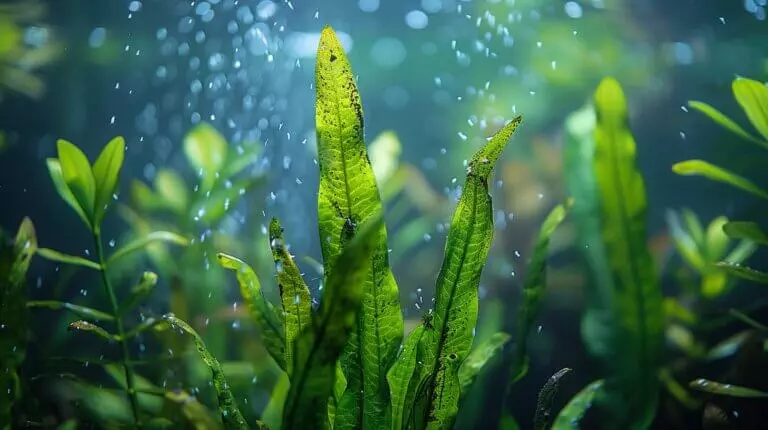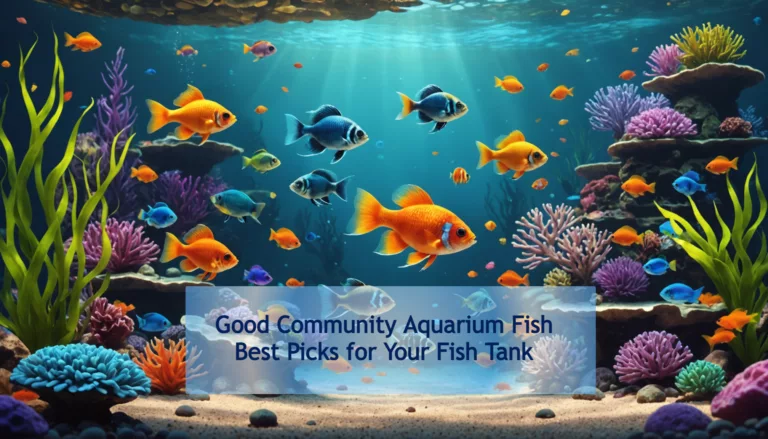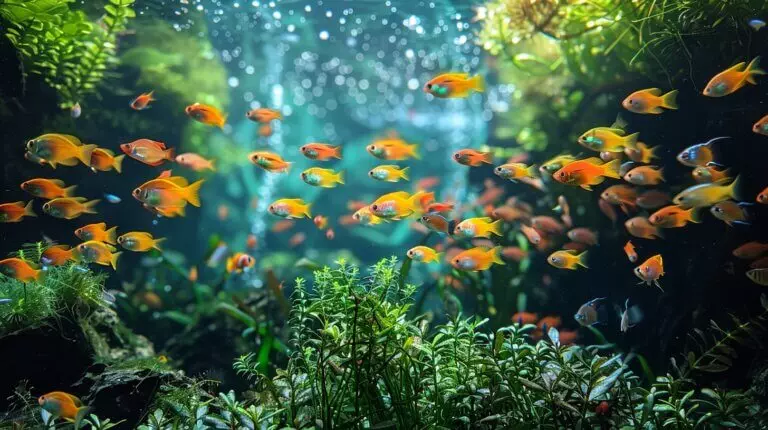Starting your first aquarium is thrilling, but choosing the best fish for small aquarium setups can feel overwhelming! Just like picking the perfect pet, finding the right fish companions requires careful consideration of size, temperament, and care needs. With countless colorful species available at pet stores, from peaceful tetras to playful danios, it’s essential to make informed choices that will thrive in your compact underwater world.
Creating a successful mini aquatic ecosystem isn’t just about selecting beautiful fish – it’s about creating a balanced community that will flourish for years to come. We’ll explore five fantastic beginner-friendly species that are perfect for smaller tanks, plus share expert tips on maintaining ideal water conditions and compatible groupings. Whether you’re setting up a 5-gallon starter tank or a 20-gallon showcase, you’ll discover exactly which finned friends will make your aquarium adventure a success.
Quick Recommendations:
- Swimming Creatures Store: Perfect for aquarium enthusiasts seeking vibrant and healthy Snowflake Dolichopterus Hypancistrus.
- Swimming Creatures Store: Ideal choice for those looking to add a variety of colorful tropical freshwater fish to their tanks.
- Swimming Creatures Store: Ensures a celestial selection of hardy freshwater fish with guaranteed quality.
- D&A Tropical Fish LLC Store: Excellent for aquarium setups needing lively and robust tropical live fish.
- D&A Tropical Fish LLC Store: Best for breeders seeking the resilient Tarzan strain for their breeding programs.
Understanding Tank Size and Compatibility with Aquarium Fish

How to Choose the Right Gallon Size for Your Fish Tank
You want to start with a tank size that keeps water conditions stable for small aquarium fish species. A 10-gallon tank offers enough space for beginner fish like guppies or neon tetras, and it’s easier to maintain than a 5-gallon nano tank. Always allow 1–2 gallons of water per inch of adult fish length to avoid heavy stocking levels. This guideline helps each fish thrive and reduces stress in your freshwater tank.
Tank Size Guidelines:
• 5 gallons: Supports a single betta or a small shrimp colony
• 10 gallons: Great for peaceful fish, such as small tetras and rasboras
• 20 gallons: Provides extra room to swim for fish kept in small groups
• 29 gallons: Lets you keep larger schools or a mix of livebearers and bottom dwellers
Essential Water Parameters for Small Aquariums
| Parameter | Ideal Range | Critical Points |
|---|---|---|
| Temperature | 75–80°F | Avoid going below 72°F or above 82°F |
| pH | 6.5–7.5 | Make slow adjustments to prevent shock |
| Ammonia | 0 ppm | Any trace above 0 requires immediate action |
| Nitrites | 0 ppm | Toxic at all levels |
| Nitrates | <20 ppm | Weekly water changes help control buildup |
Compatible Fish Species Groupings
Mixing fish from different swimming levels encourages a peaceful community fish setup. Tetras, danios, and rasboras prefer the upper areas, while platies and guppies usually swim mid-level. Bottom dwellers, such as corydoras catfish and small plecos, keep leftover food in check and enjoy planted tank setups. Choose fish with similar body shape and water requirements to limit aggression and ensure optimal comfort.
5 Best Fish for Small Aquarium: Top Choices for Beginners

Comparison Table
| Image | Product Name | Key Features | Best For | CHECK PRICE |
|---|---|---|---|---|
 | Swimming Creatures Store | • Vibrant colors<br>• Hardy species<br>• Easy to care for | Freshwater Aquariums | CHECK PRICE |
 | Swimming Creatures Store | • Diverse color palette<br>• Active swimmers<br>• Disease-resistant | Community Tanks | CHECK PRICE |
 | Swimming Creatures Store | • Guaranteed health<br>• Long lifespan<br>• Adaptable to various tank conditions | Experienced Aquarists | CHECK PRICE |
 | D&A Tropical Fish LLC Store | • Lively behavior<br>• Robust immune system<br>• Suitable for beginners | New Aquarium Owners | CHECK PRICE |
 | D&A Tropical Fish LLC Store | • Resilient strain<br>• Fast breeding<br>• Cost-effective | Breeding Programs | CHECK PRICE |
1. Swimming Creatures Store – Snowflake Pleco
The Snowflake Pleco (Hypancistrus sp.) grows to around five inches and needs at least a 20-gallon tank. It thrives in temperatures of 72–78°F, with a pH range of 6.5–7.5. This peaceful bottom dweller has bright white spots and often prefers shaded areas.
Pros:
- Effective algae control
- Calm temperament for community setups
- Minimal upkeep needs
Cons:
- Higher cost than common plecos
- Needs stable water parameters and hiding places
2. Swimming Creatures Store – Assorted Tropical Fish
Assorted Tropical Fish often range from one to three inches and come in vivid colors. They can adjust to 10+ gallon tanks if water quality remains consistent. Many species prefer warm freshwater conditions and gentle filtration.
Pros:
- Wide variety of shapes and colors
- Can mix peacefully if chosen carefully
- Ideal for beginner hobbyists
Cons:
- Some species outgrow small aquariums
- May require research to ensure compatibility
3. Swimming Creatures Store – Celestial Pearl Danio
Celestial Pearl Danios (Danio margaritatus) reach about one inch and thrive in 10-gallon tanks. They have spotted patterns across a dark body and prefer planted environments for security.
Pros:
- Beautiful pearl-like markings
- Small bioload for nano tanks
- Peaceful schooling behavior
Cons:
- Need groups of at least six
- May hide if the tank lacks plant cover
4. D&A Tropical Fish LLC Store – Live Tropical Fish
Live Tropical Fish selections can include tetras, mollies, or other small aquarium fish species. Many measure under two inches and fit well in community tanks when water conditions match their needs.
Pros:
- Easy to care for in most cases
- Often ship in healthy pairs or groups
- Offer various color varieties
Cons:
- Different species may have unique pH or temperature needs
- Risk of fin nipping if incompatible fish are combined
5. D&A Tropical Fish LLC Store – Tarzan Strain Guppy
Tarzan Strain Guppies (Poecilia reticulata) stay between 1.5–2 inches. They suit tanks of at least five gallons and feature bright colors and long fins. They also adapt to a range of water parameters.
Pros:
- Hardy livebearers with wide color selection
- Breed easily in small freshwater tanks
- Compatible with other peaceful fish
Cons:
- Males can become aggressive toward each other
- Overpopulation possible without monitoring
Best Practices for Maintaining a Healthy Aquarium

You create a thriving environment by keeping your water quality stable, feeding your fish in small amounts, and following a consistent cleaning routine. This approach helps each fish for your freshwater tank feel secure and active.
Tips for Maintaining Water Quality in Your Freshwater Aquarium
Clean water sustains healthy small aquarium fish species. You should track pH (6.5–7.5), ammonia (0 ppm), nitrites (0 ppm), and nitrates (<20 ppm) at least once a week. Keep the temperature between 75–80°F (24–27°C), and perform 10–25% water changes to remove unwanted buildup.
Key Water Steps:
• Measure pH and chemicals with a reliable kit
• Use treated tap water to prevent chlorine issues
• Match new water temperature to tank water
• Add conditioners per instructions
Feeding Guidelines for Small Fish Species: Guppies and Danios
Consistent feeding prevents leftover fish food from spoiling your aquarium water. Offer a balanced diet of quality flake food or live foods and feed only what your fish can finish in two to three minutes.
Recommended Feeding Routine:
• Morning: A small pinch of flake food
• Evening: Frozen or live foods once or twice a week
• Avoid overfeeding to protect water quality
Common Mistakes to Avoid with Serpae and Zebra Fish
Keep an eye on stocking levels and water changes for these active aquarium fish for your freshwater setup. You also want to avoid poor filter care or erratic feeding habits that trigger stress.
| Mistake | Impact | Solution |
|---|---|---|
| Overstocking | Poor water quality | Follow one inch of fish per gallon |
| Skipping changes | Toxic buildup | Perform weekly water changes |
| Irregular cleaning | Stressed fish | Set a monthly schedule |
| Neglecting filter | Less filtration | Rinse media in aquarium water |
Regular Maintenance Schedule for Small Tanks
You protect your best fish for small aquarium setups by checking tanks daily, keeping a weekly routine, and scheduling monthly deep-cleans. This method helps fish thrive without sudden changes.
Daily Tasks:
• Monitor temperature and behavior
• Remove uneaten food
• Inspect gear for malfunctions
Weekly Tasks:
• Test pH, ammonia, nitrites, and nitrates
• Change 10–25% of the water
• Rinse filter media gently
• Trim overgrown plants
Monthly Tasks:
• Siphon substrate to remove debris
• Replace worn filter cartridges
• Examine heaters or air pumps
• Wipe algae from tank walls
Current Research on Freshwater Aquarium Biodiversity

Recent institutional research shows that best fish for small aquarium setups often thrive when you mix peaceful fish of different sizes and swimming patterns. If you’re looking to make your aquarium fish for your freshwater tank healthier, consider how multiple species can balance water chemistry and reduce leftover fish food.
The Importance of Species Diversity in Small Aquariums
You gain stability and clearer water when you keep two or three compatible species together. Varied fin shapes and body sizes help break down waste at different levels of the tank. This mixture also supports better oxygen circulation, which keeps harmful ammonia levels in check.
Choosing hearty species like tetra or corydoras for compact tanks. These mixes reduce algae growth by promoting natural grazing habits.
Recent Studies on German Blue Ram Habitat Needs
Scientists report that German Blue Rams thrive in soft water with a pH of 6.0-7.0. Stable temperatures between 78-85°F encourage healthy breeding, especially in planted tank setups. You should keep them in a minimum 20-gallon tank, so each fish has room to swim and explore.
Studies find that one breeding pair is ideal for reducing aggressive behavior. They show bold colors when water is soft and temperatures are steady.
Understanding the Behavior of White Cloud Mountain Minnows
These cool-water fish often top beginner fish lists for their hardy nature. They prefer groups of six or more and stay active during daylight hours. You can keep them in unheated tanks around 64-72°F, making them perfect for small size setups.
They do well with peaceful community fish like corydoras or livebearers. Their schooling style reduces stress and improves overall health.
Latest Findings in Small Fish Community Dynamics
You create a calmer environment by mixing small tetras with bottom dwellers or pairing microrasboras with shrimp. Experts suggest aiming for one inch of fish per two gallons of water to avoid heavy stocking levels. A planted tank setup helps reduce leftover fish food and boosts oxygen for active fish.
Slow, gradual introductions reduce stress and prevent aggressive fish reactions. Extra plant cover lets you keep slightly more schooling fish without risking poor water quality.
Expert Recommendations for Choosing Freshwater Aquarium Fish

Best Fish Species Based on Aquarium Size
Tank size shapes your choices for the best fish for a small aquarium. If you have under 10 gallons, betta fish thrive alone in at least 5 gallons, and guppies or neon tetras do well in groups of six or more. According to Fishkeeping World, bettas need stable conditions to stay healthy. Another resource, LiveAquaria, suggests placing small tetras together for a peaceful community.
For a 10-20 gallon setup, you can add dwarf corydoras (six or more), white cloud mountain minnows (eight to ten), or small tetras like glowlight tetras. Platies and fancy guppies also adapt well. According to Aqueon, these species stay small and do best in schools. Tetra Fish emphasizes consistent water changes in these tanks.
Personalized Advice for New Fish Hobbyists
If you are just starting, choose hardy fish that adapt to changing parameters. Guppies are easy to care for and show bright colors. White cloud mountain minnows fit small tanks and handle cooler water. Small fish under two inches reduce stocking issues. It is recommended to add fish slowly over several weeks.
- Select species under two inches
- Establish one group of fish first
- Monitor pH and temperature weekly
- Offer small meals twice a day
- Use proper filtration to handle leftover fish food
Long-Term Considerations for Your Freshwater Tank
Most small aquarium fish species live two to five years with good care. Regular maintenance preserves water quality and supports their full lifespan. Stable temperatures between 72-78°F help fish thrive. It is important to note that adult size affects space needs.
| Species | Adult Size | Average Lifespan | Minimum Tank Size |
|---|---|---|---|
| Guppy | 1-2 inches | 2-3 years | 5 gallons |
| Neon Tetra | 1.5 inches | 3-5 years | 10 gallons |
| White Cloud Minnow | 1.5 inches | 3-5 years | 10 gallons |
| Celestial Pearl Danio | 1 inch | 3-4 years | 10 gallons |
| Dwarf Corydoras | 1 inch | 3-5 years | 10 gallons |
Creating Balanced Fish Communities
Build a peaceful community by mixing top dwellers, mid-level swimmers, and bottom dwellers. Guppies occupy the top, while tetras or danios prefer the middle. Corydoras handle leftover fish food along the bottom. Celestial pearl danios stay small and match many peaceful fish. Practical Fishkeeping recommends matching adult size and temperature ranges to encourage harmony.
Conclusion
Starting your freshwater aquarium adventure with the right fish can make all the difference! From the peaceful Celestial Pearl Danio to the eye-catching Tarzan Strain Guppy, these beginner-friendly fish species are perfect for creating a vibrant underwater community in your small tank. Remember that success depends on maintaining proper water parameters and choosing compatible tank mates.
With proper care, regular maintenance, and attention to your aquarium’s ecosystem, you’ll create a thriving habitat for your aquatic friends. Whether you’re drawn to the colorful schooling tetras or the unique personality of a Snowflake Pleco, there’s a perfect fish waiting to make your small aquarium their home. Get ready to embark on an exciting journey into the fascinating world of freshwater fishkeeping!
FAQs
1. What size tank is recommended?
Most peaceful community fish need at least 5 gallons. Schooling fish may require 10-20 gallons to let groups of six or more thrive.
2. Which equipment is essential?
Include a filter system for biological filtration and a heater for tropical temperatures. Use a thermometer to track heat levels and LED lighting for viewing. Choose a substrate that suits your fish’s needs.
3. How long should a new tank cycle?
Allow 2-4 weeks for beneficial bacteria to mature. Proper cycling lowers ammonia levels and nitrites, which keeps small aquarium fish species healthier.
4. How often should you feed them?
Offer meals 2-3 times per day. Let them consume food in 2-3 minutes. One fasting day per week is helpful.
5. How do you maintain water quality?
Test water weekly and keep ammonia and nitrites at 0 ppm. Change 10-25% of the water every one or two weeks and remove leftover food quickly.
Last update on 2025-04-17 / Affiliate links / Images from Amazon Product Advertising API











